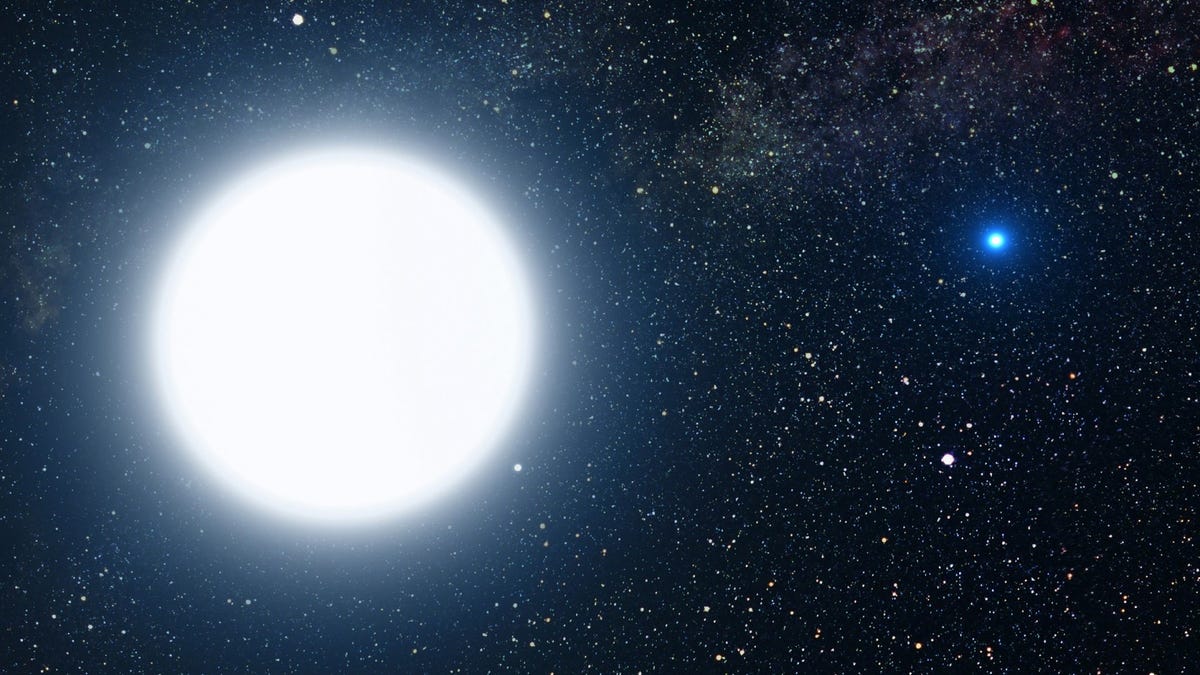NASA's Hubble telescope reveals anti-aging secrets of star corpses
"This discovery changes the definition, itself, of white dwarfs."

Sirius B, on the right, is a tiny white dwarf star -- a corpse of a star about the size of our sun. NASA's Hubble has helped reveal how these stars age.
NASA's Hubble Space Telescope just detected that some dying stars, or white dwarfs, have an anti-aging regimen effective enough to shelve an intergalactic Sephora. The stellar bodies' secret is a coating of hydrogen, which slows their postmortem cooling so much that present estimates of their age could be off by up to 1 billion years.
"Some models for slowly cooling white dwarfs had been computed in the past, [but] this is the very first time that this effect has been observed," explained Francesco Ferraro, an astrophysicist at the University of Bologna who coordinated the study of the stars published Monday in the journal Nature Astronomy.
He added, "Our discovery suggests using caution in adopting white dwarf cooling sequences as a clock."
One day, like all the other stars in the universe, our delightfully golden sun will die. It will retire from blanketing us during our morning coffee and, much like the rest of our cup of joe often forgotten on the dining table, remnants of the old star will slowly cool down. It will become a white dwarf.
White dwarfs are the last evolutionary stage of low mass stars -- like the sun -- and are sometimes referred to as the formerly blazing objects' "naked" core. Before a star enters the white dwarf realm, it energizes itself by fusing hydrogen into the slightly heavier element, helium. Once there isn't any hydrogen left, it fuses the helium into even heavier elements.
As the secondary fusion happens, the stars' outer envelopes of matter are released. That's what Hubble regularly captures in its awesome, colorful pictures of magnificent nebulae -- stars shedding their outer layers.
By comparing two huge collections of stars, M13 (left) and M3 (right), astrophysicists were able to understand how white dwarfs cool.
That leaves an exhausted, unenergized, "naked" star-corpse -- a white dwarf.
"Without any source of energy, a star can only cool down and progressively dim its luminosity," Ferraro said. "This is exactly the accepted model for white dwarfs."
Ferraro and his team's analysis of Hubble images from the telescope's Wide Field Camera 3 found that some white dwarfs are surrounded by a thin, residual layer of hydrogen that provides a final bump of energy. Thus, contrary to popular belief, not all white dwarfs dim and cool, or age, at the same rate.
"This discovery changes the definition, itself, of white dwarfs that we currently teach to students," he said. "Some stable thermonuclear burning can still occur on a white dwarf's surface."
Comparing clusters
The researchers drew their novel conclusion by comparing two similar galactic globular clusters, or areas crowded by tons of stars, M3 and M13. In fact, they're so alike that Ferraro coins them as twins.
"As in the human case," he noted, "twins are similar but not identical, and can show a few specific differences in their stellar populations."
It turns out that the white dwarf population of M13 is much larger, at 467 white dwarfs, than that of M3, at 326 white dwarfs. The stark contrast in population proves that stars' rates of cooling within the "twin" clusters aren't the same. Some of M13's white dwarfs, covered in hydrogen, are cooling slower.
"The difference was even more significant since M3 harbors more stars than M13," Ferraro said.
He says some dying stars could retain a hydrogen-rich outer envelope because they skip a step involving the mixture of elements during their degradation. Typically, that step burns away the last bits of hydrogen.
Although the team's findings point toward several age estimates of white dwarfs could be wildly incorrect, Ferraro urges that the stellar systems we use to determine the universe's age are probably safe from error. That's because astronomers also use other indicators during such inferences.
"Now, we are investigating white dwarfs in other old star clusters -- similar to M13 -- to provide additional evidence of this phenomenon," Ferraro said, relaying that he expects to be surprised by the dying stars because "they are among the most compact objects in the Universe: one teaspoon of a white dwarf weighs as much as 10 elephants."

